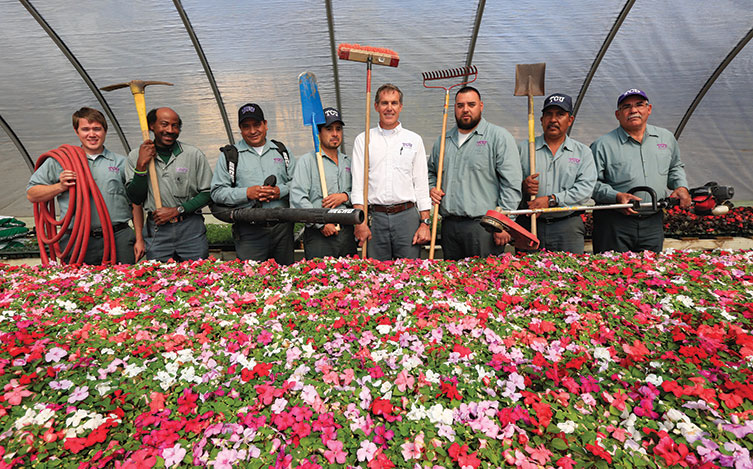Greenhouse effect . . . TCU landscaping
March is the time to plant spring flowers in Texas, and “Burdick’s Army,” was out in force.

A crew of only eight tends all the flower beds on campus. From left to right they are Ethan Long, Donald Blackshear, Gerardo Ramirez, Jose Gallegos, Greg Burdick, Joaquin Chavolla, Benjamin Casarez and Alberto Zaratee. (Photography by Carolyn Cruz)
Greenhouse effect . . . TCU landscaping
March is the time to plant spring flowers in Texas, and “Burdick’s Army,” was out in force.
At the tail end of winter, greenhouse supervisor Greg Burdick says, “It’s going to get a little crazy here in a month or so.”
And he should know. In late March, Burdick’s “army” fanned out over the campus to transplant the thousands of annual bedding plants that make the TCU campus such a showplace. Year round, Burdick’s crew fills the TCU greenhouses (hidden behind the Physical Plant buildings) with the begonias, impatiens, geraniums, petunias and dianthus that make up the beds that decorate campus buildings.
Annual bedding plants are grown year-round, mostly from thumb-sized plugs obtained from a local grower. Burdick’s team transplants these tiny starts into small containers in flats, then fertilizes them with a diluted liquid fertilizer. Six to eight weeks after transplanting, these annuals will be ready to set out in beds and planters all over campus.
Some annual flowering plants, such as marigolds and zinnias, are grown from seed sown directly in planting beds.
At each re-planting, the annual beds are roto-tilled and amended with peat moss and red lava sand — organic products that improve the water-holding capacity and tilth (the proper structure and nutrients in the soil). A slow-release balanced (14-14-14) fertilizer is also added to each planting bed.
Thousands of flowering bulbs are planted each fall and tulips are the stars of the spring show. Hyacinths are used mostly in large containers such as the urns outside the Brown-Lupton University Union and Dee J. Kelly Alumni & Visitors Center.
Because neither tulips nor hyacinths are reliable re-bloomers in Texas, these bulbs are discarded after blooming. Daffodils are planted patterns within beds of Asian jasmine that are never disturbed, and they bloom every year. Perennial flower beds include roses, iris, lantana, cannas and daylilies and are less labor-intensive than the bulb and annual beds.

Because of the hardiness of Burdick’s annuals, the plants themselves prevent most weeds from sprouting and spreading. What little weeding is needed is done by hand by the crew throughout the growing season. No herbicides are used, but a low-toxicity insecticide is applied to the beds if needed.
Burdick and his team monitor the planting beds constantly, looking for signs that it’s time to change them out, or just for weeding and maintenance needs.
Besides caring for the many annual and perennial beds on campus, Burdick’s crew mows and edges the lawns, string-trims the tall grass around the Worth Hills pond and other locations and does some trimming of low-hanging tree branches.
More complicated tree-trimming is contracted out. “We don’t climb trees,” says Burdick.
The trimmings from trees and shrubs are chipped and recycled as mulch in beds and other areas, saving the university thousands of dollars a year.
After the spring craziness, the greenhouses will be filled with growing transplants for the summer beds, which will include verbenas, scaevola, coleus, caladiums and more begonias. And Burdick’s Army will get ready for another season.
The question often arises, why does TCU spend so much money planting flowers?
Of course the beauty makes it all worth it; and it doesn’t come out of the operating budget. In 1987, TCU benefactor and Board of Trustees member Mary Evans Beasley established the Mary Evans Beasley Endowment Fund for Campus Beautification with an initial gift of $100,000. With additional gifts until her death in 2005, the fund now exceeds $800,000 and continues to pay for planting the flower beds, maintenance and watering.
Related story:
Planting tips

Your comments are welcome
Comments
Related Reading:
Features
Infographic: Minors
A wide variety of minors gives TCU students the chance to add depth to their majors or dive into new areas.
Features
Venture Capitalism 101
MBA students connect investors and startups in a Neeley program.